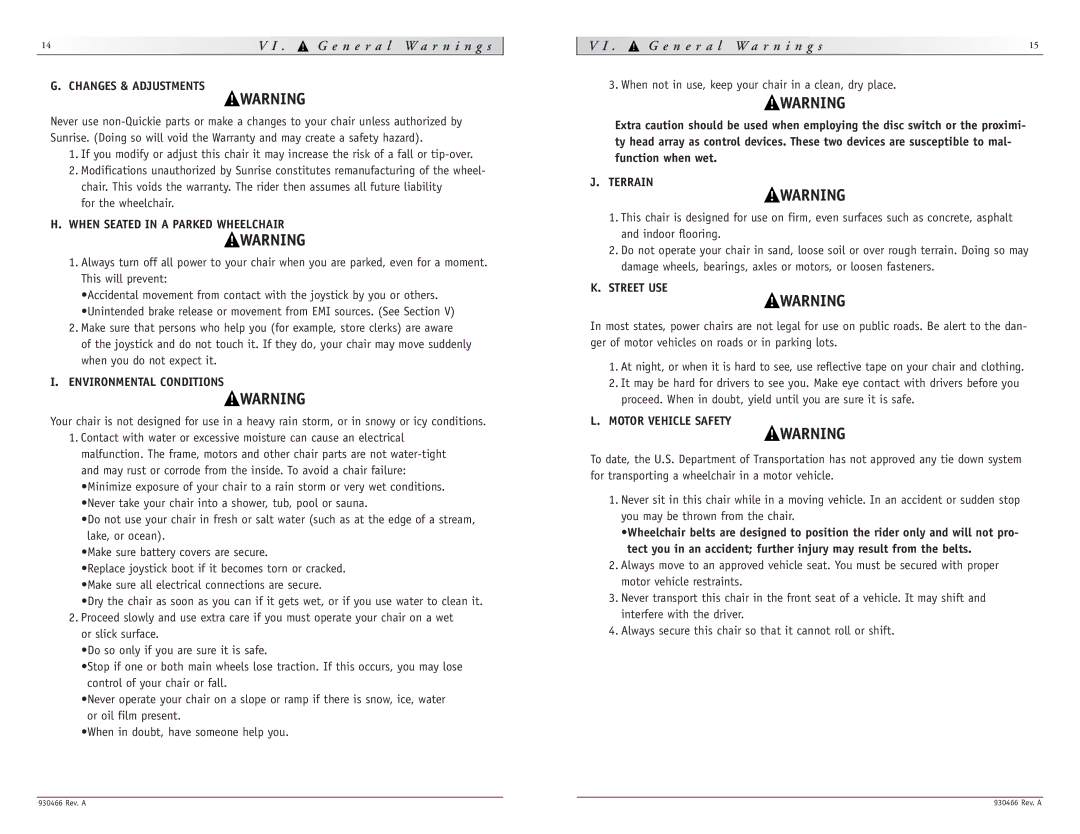
14 |
|
|
|
|
|
|
|
|
|
|
|
|
|
|
|
|
|
|
|
|
|
| V | I | . |
|
|
| G | e | n | e | r | a | l |
| W | a | r | n | i | n | g | s |
|
G. CHANGES & ADJUSTMENTS
Never use
1.If you modify or adjust this chair it may increase the risk of a fall or
2.Modifications unauthorized by Sunrise constitutes remanufacturing of the wheel- chair. This voids the warranty. The rider then assumes all future liability
for the wheelchair.
H.WHEN SEATED IN A PARKED WHEELCHAIR
1.Always turn off all power to your chair when you are parked, even for a moment. This will prevent:
•Accidental movement from contact with the joystick by you or others.
•Unintended brake release or movement from EMI sources. (See Section V)
2.Make sure that persons who help you (for example, store clerks) are aware
of the joystick and do not touch it. If they do, your chair may move suddenly when you do not expect it.
I.ENVIRONMENTAL CONDITIONS
Your chair is not designed for use in a heavy rain storm, or in snowy or icy conditions.
1.Contact with water or excessive moisture can cause an electrical malfunction. The frame, motors and other chair parts are not
•Minimize exposure of your chair to a rain storm or very wet conditions.
•Never take your chair into a shower, tub, pool or sauna.
•Do not use your chair in fresh or salt water (such as at the edge of a stream, lake, or ocean).
•Make sure battery covers are secure.
•Replace joystick boot if it becomes torn or cracked.
•Make sure all electrical connections are secure.
•Dry the chair as soon as you can if it gets wet, or if you use water to clean it.
2.Proceed slowly and use extra care if you must operate your chair on a wet or slick surface.
•Do so only if you are sure it is safe.
•Stop if one or both main wheels lose traction. If this occurs, you may lose control of your chair or fall.
•Never operate your chair on a slope or ramp if there is snow, ice, water or oil film present.
•When in doubt, have someone help you.
 V I .
V I . 
 G e n e r a l W a r n i n g s
G e n e r a l W a r n i n g s 









 15
15
3. When not in use, keep your chair in a clean, dry place.
Extra caution should be used when employing the disc switch or the proximi- ty head array as control devices. These two devices are susceptible to mal- function when wet.
J.TERRAIN
1.This chair is designed for use on firm, even surfaces such as concrete, asphalt and indoor flooring.
2.Do not operate your chair in sand, loose soil or over rough terrain. Doing so may damage wheels, bearings, axles or motors, or loosen fasteners.
K.STREET USE
In most states, power chairs are not legal for use on public roads. Be alert to the dan- ger of motor vehicles on roads or in parking lots.
1.At night, or when it is hard to see, use reflective tape on your chair and clothing.
2.It may be hard for drivers to see you. Make eye contact with drivers before you proceed. When in doubt, yield until you are sure it is safe.
L.MOTOR VEHICLE SAFETY
To date, the U.S. Department of Transportation has not approved any tie down system for transporting a wheelchair in a motor vehicle.
1.Never sit in this chair while in a moving vehicle. In an accident or sudden stop you may be thrown from the chair.
•Wheelchair belts are designed to position the rider only and will not pro- tect you in an accident; further injury may result from the belts.
2.Always move to an approved vehicle seat. You must be secured with proper motor vehicle restraints.
3.Never transport this chair in the front seat of a vehicle. It may shift and interfere with the driver.
4.Always secure this chair so that it cannot roll or shift.
930466 Rev. A | 930466 Rev. A |
